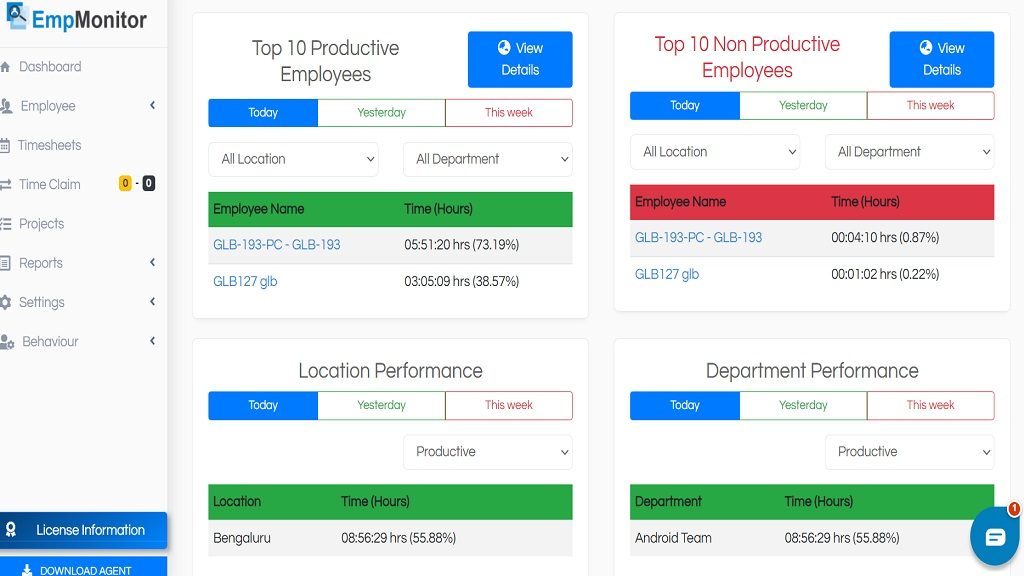You do not have to be a software engineer to know what agile metrics are. This concept extremely applies to everything related to software building and deployment. Stick with us till the end because we are about to take you on a tour of modern team management methodology.
Agile is a term that refers to the ability to be consistent, disciplined, and dedicated to finishing the project within the required timeline. Well! The agile methodology breaks down the effort of the team into measurable units so that the team leader can evaluate the process and outcome of the project and manage the team as well!
In other words, agile metrics involve three aspects – project team, stakeholder, and the process of communication between these two groups. Learning about this requires acknowledging and understanding the process of agile software development and deployment.
In the modern world, agile performance is the key to working proficiently. The project managers and stakeholders seek figures that might seem irrelevant, but they are crucial. As the quote of a famous physicist says –
“Not everything that counts can be counted, and not everything that can be counted counts.”
~ William Bruce Cameron 1963
Source quoteinvestigator.com
You can understand from the quote that not every time does numerous figures matter. Even if they are, then what for? Yet, with agile methodology, you have to find a way to estimate those factors which you cannot express in figures. So, you can see! Things are not as clear-cut as they may seem.
In agile team development matrices, we use the Kanban Method that organizes the flow of work into the team. To understand Agile Metrics, we need to first go through the Kanban Method of work.
So let us go for it!
What Is Kanban Method Of Work?
As per kanbanize.com, Kanban is a Japanese method of managing the work module and process. It involves only one thing, that is – making a chart board that shows every aspect of your work model. With Kanban, it is easier for anyone to visualize the project and improve efficiency in the work.
Operating the project with a more calculated mindset helps the agile project teams to access their quality of work themselves. It is core psychology that visual boards or charts help us improve our work efficiency and motivation.
The Kanban method can be a great help to resolve the issue regarding the pace of work.
There is a famous quote by Dr. Thoralf Sundt –
“If I can see it, I can fix it.”
Effective management begins with accessing the issues and guiding oneself to resolve the problems. And delivering quality service requires you to monitor yourself.
Well! Not everyone is blessed with having bigger spaces to install Kanban boards, but that does not mean you cannot monitor yourself. EmpMonitor is one such software that keeps your monitoring issues at bay.
What It Is Like Monitoring With EmpMonitor Software?
EmpMonitor is a cloud-based employee monitoring software that helps you keep records of your employee activities and productivity infographics. Along with that, you can easily access timesheets to track the attendance, leaves, online-offline activities/ status, productive/ unproductive hours, keystrokes, user screen snapshots, webcam shots, geolocation, web-history, application-history, and HRMS window (Human Resource Management System).
EmpMonitor plays by the Kanban philosophy. The software comes with the feature where employees can see their timesheets and access themselves on the basis of it.
Employee managers can add as many employees as they want in EmpMonitor. The software does not have restrictions in team member limits and data assortments because it is developed with the intention of managing and monitoring companies regardless of their size.
The employee managers can allow the employees to visit their own productivity records to maintain transparency. Also, employee managers can do IP blacklisting or whitelisting for the respective employees to control Insider Data Breach Threats. Visit the page to know more.
What Is Agile Metrics?
So, we have already understood the function of the kanban method and its importance in calculating agile performance. Now, let us move on to perceiving the meaning of agile metrics.
It is a measurement and evaluation framework for modern software development. The agile methodology provides key metrics that allow teams and stakeholders to understand how well they are doing at reaching their objectives and how they can improve.
This process helps organizations achieve their objectives by channeling the Kanban methods of workflow management.
Agile metrics can be used by anyone involved in software development, such as managers, project sponsors, business analysts, testers, and developers. The overall agile project management requires more than setting the budget and scope of the project. One has to evolve the workflow practices in a way that it can entertain sudden changes. And evaluate feedback from stakeholders before implementing it.
This Agile manifesto is a bit long and clunky to recite in a sentence, but the basic idea is that knowledge work is very different from factory work. You cannot just set a date, a scope, and a budget and roll out a new version of your product every few months. Instead, it involves constant iteration, improvement based on customer feedback, and frequent releases.
To that end, the Agile manifesto lays out the following key principles –
- Individuals and interactions over processes and tools,
- Working software over comprehensive documentation,
- Customer collaboration over contract negotiation,
- Responding to change over following a plan,
- And evaluating stakeholders’ feedback as per the current project status over acting upon every request for change.
The Importance Of Agile Metrics
In any organization, agile metrics are one of the few universal methods of quantifying the results of your efforts. In fact, many employers have actually been using them for years to measure their own contributions.
Based on the agile methodology, these metrics are transparent, easy to understand, and can be adjusted or changed based on the needs of the organization. Well! They are used for all kinds of industries and companies, but they can be especially relevant for smaller businesses like startups.
However! In the end, it is all about delivering quality service to our clients. And this is something agile metrics specializes in!
Let us understand the importance of agile performance metrics with the help of two examples.
As we all know that agile methodology is a new way of managing workflow, which includes Kanban pattern and logic. But if we remove Kanban practices, what will be left then?
Let us assume two teams, team A and B. Here, both the teams are assigned one client project. Now let us suppose team A is proceeding with the client project in a waterfall approach which includes the following practices –
- Communication,
- Planning,
- Modeling,
- Construction,
- Deployment.
It is a simple one-liner approach that focuses on delivering the final product rather than incorporating changes. This approach may seem quick but harbors many challenges because of its inability to entertain mid-way changes.
Well! Moving on to team B! Let us assume that it is ready to proceed with the client project in an agile approach, which includes the following practices –
- Listing out the requirements of the client in priority order,
- Choosing core or basic requirements that the team can accomplish in a short span,
- Following the waterfall approach to creating an initial sample product for the client,
- Acting upon client feedback and incorporating remaining requirements along with adding or subtracting anything on the requirement list.
- Delivering the second sample to the client and analyzing their feedback.
If things are in your favor, I hope the second sample becomes your final product. But if not, then you need to go through the waterfall approach in response to the current feedback to create the third sample.
So, here you can see that the agile metrics Approach allows you to entertain changes without wasting your time and budget.
Let us have a quick run down to the factors that make agile methodology a better way to lead a project.
Benefits Of Agile Methodology
- Eliminates the chances of complications within the final product.
- Welcomes changes
- Saves time and budget.
- Focus on having clear communication over the final product.
- Gives project managers a window to analyze feedback before rushing to act on it.
- Helps the team to back out from the project during unfortunate situations where the client decides to discontinue the project.
How To Measure Quality Metrics In Agile?
Agile metrics are essential to measuring how well your organization is doing when compared to your goals. Making sure these metrics are directly related to your business goals is the first step to measuring quality metrics since comparisons made without considering them will not paint an accurate picture of your success.
Well! We all operate in different niches and project requirements, but there are some core approaches that we all can follow to measure the quality metrics of our agile performances.
Sometimes, some non-technical facts and figures matter more than basic numerical ones; because the ethics that drive the workflow are not measurable if we are restricted to numerical values only.
So, here are some non-numerical agile metrics for absolute workflow quality and project management.
Scrum
Scrum is nothing but a group of professionals who come together to make the team and finish the assigned client project. They usually discuss the project blueprint regarding the various aspects of the project. You can perceive that the scrum includes teammates who are business managers, client managers, task managers, and technicians of respective niches who will do the nitty-gritty of the project.
Product Burndown
In this step, the scrum team creates a list of client project requirements; as per the respective priority.
Sprint Planning
In this step, the scrum team plans out the blueprint of the initial process, where they will be delivering the initial increment (sample) to the client.
Also, since we all know that the first increment is never the final one. Therefore, sprint planning requires mapping out some further aspects of the project.
For example, creating a sprint backlog where the scrum team will select specific requirements from the product burndown to add in the sprint backlog.
Scrum Meeting
Scrum meeting is nothing but the EOD (end of the day) meeting where the team members discuss the overall activities, challenges, and accomplishments they had during the day. This meeting is held every day in the scrum timebox. Here the timebox refers to the deadline duration of the project.
Calculate Agile Metrics With Team Velocity
Team velocity is the pace of the work within the team in which they are addressing the project. Usually, it is four to six weeks.
Conduct Sprint Review
After completion of a certain timebox, scrum releases the number of product increments, which we call ‘potentially shippable product increment’. And each time, they conduct a sprint review. In this review, the team accesses the increment product to explain the client.
Sprint Retrospective
After getting the feedback from the client, it is time to analyze the project. In the sprint retrospective, the team does not talk about the product. Instead, they talk about the overall journey of the project, the positives, and negatives, ways they can improve the plan for the project, and analyze the feedback of the client.
How Does Testing Metrics In Agile Works?
Agile Metrics provides insight into the performance of agile teams by delivering quick metrics that help you direct your efforts to improve your team’s velocity. Finding the things that slow down your team can be hard, but this is precisely what agile metrics can help you discover.
By perceiving the causes of your team’s velocity loss, you can discover the perfect places to focus your efforts. Well! It might seem difficult to track the productive and unproductive activities of your teammates if you are doing it manually. That is why many managers prefer to have employee management software, such as EmpMonitor.
Anyway! One manual method to keep track of your agile team is testing the metrics to find the loopholes in the workflow. Since agile projects require the team to collaborate with each other, the system stability is both fragile and strong from all angles. The agile metrics of work is cross-functional. It means everybody depends on everybody! And in such a scenario, testing the matrics is the priority to improve the efficiency of the team.
So, let us discuss the key recipe of testing metrics in agile.
Automate Testings Of Countable Factors
It always proves convenient to have an automated report of the work. Such as, the user screen activity report sounds good.
This report can consist of the web history, application history, keystroke records, user screen screenshots, and screen records. The reports generated from these factors can create a firm activity and productivity analytics that can help you understand the efficiency of your teammates in the long run.
Detect Agile Metrics Throughput: Project Time Cycle / Timebox
In an agile project, you have several product increments before the final product. So use those time cycles to know how efficient your team is!
Here, Project Time Cycle refers to the overall time taken by an agile team to finish one product increment. And the timebox refers to the overall deadline of the final product. The best agile throughput is always less than zero.
Consult With Project Analysts:
After every product increment release, consult with the project analyst to find out about escaped defects or loopholes that can meticulously affect the project. Also, analyze the time and budget factors to implement any further changes.
Sprint Burndown
Sprint burndown is the list of features and services that seem relevant to add in the specific product increment. Discuss with your technical team to create that list and plan accordingly.
Introduce Three-Time Task Update For Better Productivity
This method of updating three times a day is the most direct, transparent, and summarised way to inform the superiors about how the day went. Many firms apply this method and are thriving at their workflow stats.
In Conclusion
Agile Methodology is used to help businesses understand and improve their Agile performance. Out of the box, it provides several important metrics to help Agile teams build better software.
These agile metrics are often used to review employee performance. But they are applied to software development to manage programming teams more efficiently and eventually became the best practices for running organizations in general.
















